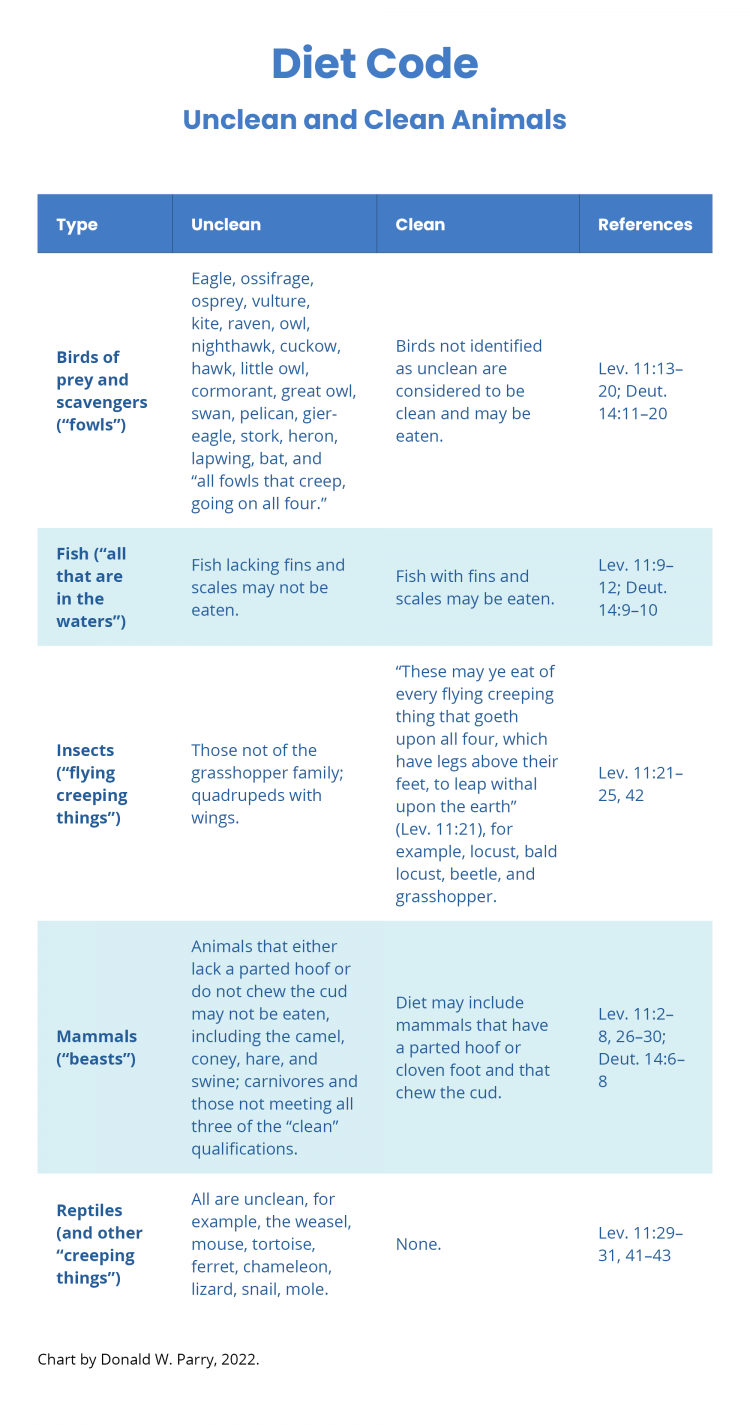You are here
Diet Code: Unclean and Clean Animals
| Title | Diet Code: Unclean and Clean Animals |
| Publication Type | Book Chapter |
| Year of Publication | 2022 |
| Authors | Parry, Donald W. |
| Book Title | The Jesus Christ Focused Old Testament: Making Sense of a Monumental Book |
| Chapter | 51 |
| Pagination | 134-135 |
| Publisher | Book of Mormon Central |
| City | Springville, UT |
Show Full Text
The lord revealed to Moses a strict and specific diet code regarding unclean and clean animals, which had both spiritual and temporal purposes. Temporally, the code protected the Israelites from disease and from unwise economic practices. “The vast majority of foods prohibited [in the law of Moses] are those that (1) are more likely to carry disease in the arid climate of the Sinai desert and/or the land of Canaan; or (2) are foolishly uneconomical to raise as food in the particular agrarian context of the Sinai desert and/or the land of Canaan.”[1]
Spiritually, the diet code prepared the people to sanctify themselves and to become holy, even as the lord God is holy: “For I am the lord your God: ye shall therefore sanctify yourselves, and ye shall be holy; for I am holy. . . . This is the law of the beasts, and of the fowl, and of every living creature that moveth in the waters, and of every creature that creepeth upon the earth: To make a difference between the unclean and the clean, and between the beast that may be eaten and the beast that may not be eaten” (Lev. 11:44, 46–47).
Accordingly, the core of the matter pertaining to the “law of the beasts” is its spiritual aspects, which focus on the lord and His holiness! He is holy, and He required ancient Israel to sanctify themselves and to be holy.
|
Type |
Unclean |
Clean |
References |
|---|---|---|---|
|
Birds of prey and scavengers (“fowls”) |
Eagle, ossifrage, osprey, vulture, kite, raven, owl, nighthawk, cuckow, hawk, little owl, cormorant, great owl, swan, pelican, gier-eagle, stork, heron, lapwing, bat, and “all fowls that creep, going on all four.” |
Birds not identified as unclean are considered to be clean and may be eaten. |
Lev. 11:13–20; Deut. 14:11–20 |
|
Fish (“all that are in the waters”) |
Fish lacking fins and scales may not be eaten. |
Fish with fins and scales may be eaten. |
Lev. 11:9–12; Deut. 14:9–10 |
|
Insects (“flying creeping things”) |
Those not of the grasshopper family; quadrupeds with wings. |
“These may ye eat of every flying creeping thing that goeth upon all four, which have legs above their feet, to leap withal upon the earth” (Lev. 11:21), for example, locust, bald locust, beetle, and grasshopper. |
Lev. 11:21–25, 42 |
|
Mammals (“beasts”) |
Animals that either lack a parted hoof or do not chew the cud may not be eaten, including the camel, coney, hare, and swine; carnivores and those not meeting all three of the “clean” qualifications. |
Diet may include mammals that have a parted hoof or cloven foot and that chew the cud. |
Lev. 11:2–8, 26–30; Deut. 14:6–8 |
|
Reptiles (and other “creeping things”) |
All are unclean, for example, the weasel, mouse, tortoise, ferret, chameleon, lizard, snail, mole. |
None. |
Lev. 11:29–31, 41–43 |
Terms of Use
Items in the BMC Archive are made publicly available for non-commercial, private use. Inclusion within the BMC Archive does not imply endorsement. Items do not represent the official views of The Church of Jesus Christ of Latter-day Saints or of Book of Mormon Central.
Bibliographic Citation
Scripture Reference
Subscribe
Get the latest updates on Book of Mormon topics and research for free

